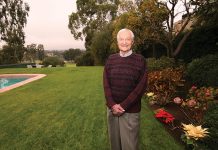When Dan Scanlon was about 9 years old, he entered the . His father had died when he was young, a tragedy that would one day fuel his writing and directing of the Pixar film , which would be nominated for best animated feature for the Golden Globe and Academy awards in 2021. But all that was far away.
In the mid-ā80s, the Clawson kid just knew that he wanted to make movies, and like so many other kids with unique interests in a pre-internet world, he had no idea if there were other kids like him.
His āBigā at Big Brothers Big Sisters took him to the annual , organized by the Royal Oak-based nonprofit , and it was there he met John Prusak for the first time.
Over the next few years and after submitting a few films, he made it into the festival himself and won a spot in a weeklong work-shop DAFT hosted called Focal Point, where Prusak was his instructor.
āThere were adults in the class as well,ā Scanlon, now 46, says. āAnd John really treated us all the same. We were all equal new filmmakers. And that week was so crucial to me: to see that there were other people who loved making films, to see that there was a community in Detroit of filmmakers that John was sort of the leader of.ā
Scanlon, who cut his teeth as a storyboard artist on Pixarās and, is among many filmmakers who cite Prusak as an instrumental part of their success. Prusak died March 15, at age 75, from complications from COVID-19, years after being diagnosed with Parkinsonās disease.
He was a Detroit native and Corktown resident, a fierce and loving devotee to the city and its baseball team (and its original ballpark). He had a deep passion for filmmaking, with credits on more than 60 films, most of them local and independent, many of them about Detroit, and for 50 years was an instrumental member of DAFT.
His students include Oscar winners, industry professionals, and local enthusiasts making independent films, as well as teachers now leading the next generation of young filmmakers.
āHe liked to see the light bulb come on,ā his wife, Barbara Prusak, says. āA lot of his students, they just heard a different drummer, always.ā
Kathy Vander was a longtime friend, colleague, and student of Prusakās and a longtime board member of DAFT. Like many of Prusakās students, she met him at a Focal Point seminar, calling him a ātall, good-looking guy, ā¦ kind of a quiet giant.ā
During that workshop, Vander made a short film on a community of Hmong women in Detroit. When the workshop was over, she wanted to keep working on it and expand it into a longer documentary.
āAnd John was like, āIām on board.āā That was the first of many times that Vander became a colleague of Prusakās, not simply a student.ĢżDoug Blush, who has won Academy Awards for his work on the documentaries and, this year, The Elephant Whisperers, calls the Focal Point seminars āa kind of fantasyland.ā
āHe never underestimated us,ā Blush says. āAnd he never thought that we werenāt worthy of doing it. Even if we were beginners and we made dumb mistakes ā and we made dumb mistakes. He had that great smile, ā¦ that sort of gentle smile that had just a little bit of mischief in it.ā
Shortly after Prusakās death and winning an Academy Award for , Blush wrote on social media, āMy friend and mentor John Prusak has passed. ā¦ An absolute Detroit film legend, he was the first person to hand me a 16 mm camera and say, āgo make something.ā
āHe taught so many kids about the wonder of filmmaking,ā he continued. āI would not have made it to the Oscar stage on Sunday without his ā¦ kindness, guidance and encouragement.ā
āEncouragementā is a word that continues to come up when Prusakās students talk about him. Douglas Chiang is the vice president and executive creative director for , and was handpicked by George Lucas himself in 1995 to head up the art department for episodes I and II of the Star Wars franchise.
In a 2022 interview he credited Prusak for helping him get to where he is. āThrough the [Michigan Student Film] festival, I met my film mentor John Prusak,ā he told . āJohn showed me proper filmmaking techniques, gave me access to professional equipment, and most importantly, encouraged me to pursue my passion.ā
Scanlon says Prusakās encouragement was crucial to him as a young man who was unsure of his abilities. He also says learning the nuts and bolts was invaluable.
āIn the arts, thereās a fear to ascribe one way to do something. ā¦ Especially when I was in college,Ģża lot of my teachers would say, āArt is intangible. Iām not going to show you how to do it. You have to figure it out on your own.ā Or, āIt comes from your heart.ā And all that stuff is great, but Iām learning and I want someone to give me some tools. And I think that takes confidence as a teacher to say, āHereās what I would do. Hereās the focal range I would set on your camera. Hereās what Iāve learned in the past.āā
A Teacher of Teachers

After Prusak graduated from Henry Ford High School in Detroit, he knew he had to get out of town. His brother was running with a rough crowd, Barb Prusak says, and he knew if he didnāt make some changes, he would be headed down a similar path.
He went about as far away as you can get while staying in the state, attending Northern Michigan University in the Upper Peninsula, where he studied visual arts before returning to Detroit. He would later earn a masterās degree from the University of Michigan in Ann Arbor in radio, television, and film.
When he returned home, he started teaching art at Lincoln Elementary in the Wayne-Westland district, where he became known as the guy who did the bike rides.
At the end of each school year, Prusak and another male art teacher (āAnd at that time, you know, how many male art teachers are there?ā Barb Prusak says) would take students on a weeklong bike trip. Part of the catch was that each kid had to provide their own bike ā but if they didnāt have one, Prusak and his counterpart would help the kids get the necessary parts and build their own.
Later, the district opened a vocational center with a darkroom, and Prusak began teaching classes or workshops there in the evening, in addition to his day job at Lincoln Elementary.
āHe was busy all the time,ā Barb Prusak says.
In 1969, two teachers from Cranbrook Schools, Bill Moran and John Geoghegan, started DAFT, then known as Detroit Area Film Teachers.
Prusak attended one of DAFTās Focal Point seminars in 1972. His friend and former college classmate Dick Rockwell, another film teacher who got involved with DAFT, recalls that Prusakās film project that week was āa montage of Vincent van Gogh paintings cut to the music of Don McLeanās song āVincent.āā The following year, Prusak was asked to be an assistant instructor for Focal Point.
DAFT grew, bringing in more schools and holding more festivals, the same festivals where Scanlon and Blush and so many others were able to showcase their work and find an audience ā and community. It continued offering training for students as well as teachers, helping them create curricula for their classrooms. Kevin Walsh, DAFTās current treasurer and co-director of its film festival, says they also work with colleges and media professionals, staying up to date on what skills schools and employers are looking for.
āDAFT was very revolutionary in its approach to teaching film to students in Michigan,ā Vander says. āUp until that point, there were professional organizations for people who were working in media, but as far as learning filmmaking, you needed to go to a school. But DAFT ā¦ was an anomaly in that way.ā
Walsh, who has taught video production (and more) in the Royal Oak, West Bloomfield, and Southfield school districts, was teaching at West Bloomfield High School when he joined DAFT in 2002.
āItās really turned into a nice support system. [In a high school] you canāt just walk down the hall and meet people who are in your field.ā
This year, the 55th annual Michigan Student Film Festival ā which is co-sponsored by the at the ā will showcase the works of hundreds of students. In 2022, Walsh says, there were 335 entries representing more than 800 students from five schools. He expects this yearās numbers to be similar.
āIt just feels so good to have our students not just succeed but go far beyond our expectations,ā Rockwell says. āThey become so much better than us. Itās amazing.ā
Detroit Dedicated

In the ā80s, Prusak was a cameraman for Michael Mooreās , a film that would win many awards, including a Award, and launch Mooreās career as a controversial documentarian ā a wave of success that Prusak could have, perhaps, used to take his career in a different direction.
He made films ānot ever thinking that any of them would be a success,ā Barb Prusak says. āHe just wanted to document people. ā¦ Making a film for him was an adventure.ā
He never had any desire to be anywhere other than Detroit, she says. Never, she says, did he consider heading west and giving Hollywood a try.
āI think he loved Detroit so much that it was hard for him to separate himself from Detroit,ā Blush says. āAnd especially because he taught and cared about the community and he cared about Corktown. He cared about Detroit as a place and the sports and the life there. And I feel like he was part of the city. You know, some people really are a part of the city that they come from.ā
Vander, who spent time at WXYZ doing short documentary-style videos, continued working on independent films locally with Prusak, with both of them usually listed as co-producers ā a strange transition, she says, to be taken seriously as an equal by her mentor.
āThe hardest part was, because he was my teacher, he would have an opinion, and then I would go, āNo, no, no, I want to do it this way.ā And then weād have a little back and forth, and then, you know, sometimes heād win, sometimes Iād win. But being the student, youāre always the student, in a way, to John, forever. Forever.ā
This story is from the June 2023Ģżissue of Ā鶹·¬ŗÅ Detroit magazine. Read more in our digital edition.
|
| Ģż |
|








